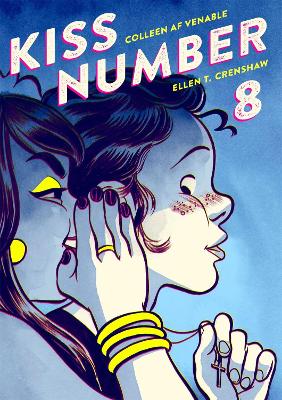Reviewed by nannah on
Content warnings:
- transphobia
- homophobia
- homophobic slurs
- domestic abuse
- misgendering
- sexual coercion
Representation:
- Amanda, the MC, is bisexual (though, of course, the word is never actually said)
- lots of secondary characters are lgbt
- Cat, one of the main characters, isn’t white
- there are also many secondary characters who are poc
So far, Amanda Orham has had seven not-so-great kisses. But nothing compares to the awfulness that is Kiss Number Eight, which sends her world into chaos. Amanda goes to a private Catholic school and grew up in a conservative household, so when her eight kiss is with a girl, everyone she loves -- including herself -- is beyond shocked. Kiss Number Eight is a book about exploring sexuality, about friendship -- when it works, when it doesn't, when you might need to find new friends who support you -- and mostly about family.
Okay, while I’m in love with the art style (WOW is it ever beautiful and expressive!), I can’t say the same for the story. The concept itself of a girl with a Catholic upbringing following a mystery letter to discover her grandfather was trans, and then discovering that she herself isn't straight? Is fantastic, and sounds like an amazing story. And don’t get me wrong, every moment spent with Amanda and her family is masterfully told and the highlight of the graphic novel no question. Another thing the novel does well is showing how hatred and intolerance is learned. There’s a flashback scene that almost made me cry because it’s just so well done.
But then there’s also that question: who is this written for? Because in the end, there was a lot that made me feel more awful about being who I am than made me feel hopeful (which is the book’s purpose, according to the summary). In over three-fourths of the novel, Amanda, her family, and friends use slurs and talk about how disgusting lgbt people are. They do grow (some of them), but having Amanda shout “Ew! Ew! Eww!” while laughing in response to her friend scornfully wondering if Amanda’s grandfather had surgery (in regards to transitioning) is excruciating. The characters also misgender the trans man for about half the novel, and they call him “sick”, etc. It becomes incredibly difficult to read, at least for me, who experienced abuse at the hand of my family, and some because of my identity. It’s very explicit here, and it’s why I’m wondering who exactly this graphic novel was written for.
Me, for one … I don’t want to read this. If I wanted to read about lgbt folk being abused and misgendered, I could just take a walk outside or call the family I’ve cut off. It feels like this story was meant for people who are not lgbt, to look in on what we’ve experienced, and be like “oh”. Which … isn’t necessarily a bad thing? But it alienates lgbt readers … when the book is about lgbt people. I guess it’s just knowing who you’re writing for. And maybe I’m missing the point, and this was the author’s intent all along.
In which case, the book just wasn’t for me!
Reading updates
- Started reading
- 4 March, 2020: Finished reading
- 4 March, 2020: Reviewed
